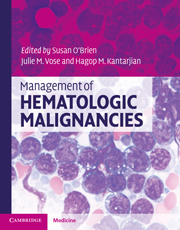Book contents
- Frontmatter
- Contents
- List of contributors
- 1 Molecular pathology of leukemia
- 2 Management of acute myeloid leukemia
- 3 Treatment of acute lymphoblastic leukemia (ALL) in adults
- 4 Chronic myeloid leukemia
- 5 Chronic lymphocytic leukemia/small lymphocytic lymphoma
- 6 Myelodysplastic syndromes (MDS)
- 7 Hairy cell leukemia
- 8 Acute promyelocytic leukemia: pathophysiology and clinical results update
- 9 Myeloproliferative neoplasms
- 10 Monoclonal gammopathy of undetermined significance, smoldering multiple myeloma, and multiple myeloma
- 11 Amyloidosis and other rare plasma cell dyscrasias
- 12 Waldenstrom's macroglobulinemia/lymphoplasmacytic lymphoma
- 13 WHO classification of lymphomas
- 14 Molecular pathology of lymphoma
- 15 International staging and response criteria for lymphomas
- 16 Treatment approach to diffuse large B-cell lymphomas
- 17 Mantle cell lymphoma
- 18 Follicular lymphomas
- 19 Hodgkin lymphoma: epidemiology, diagnosis, and treatment
- 20 Treatment approaches to MALT/marginal zone lymphoma
- 21 Peripheral T-cell lymphomas
- 22 Mycosis fungoides and Sézary syndrome
- 23 Central nervous system lymphoma
- 24 HIV-related lymphomas
- 25 Lymphoblastic lymphoma
- 26 Burkitt lymphoma
- Index
- References
9 - Myeloproliferative neoplasms
Published online by Cambridge University Press: 10 January 2011
- Frontmatter
- Contents
- List of contributors
- 1 Molecular pathology of leukemia
- 2 Management of acute myeloid leukemia
- 3 Treatment of acute lymphoblastic leukemia (ALL) in adults
- 4 Chronic myeloid leukemia
- 5 Chronic lymphocytic leukemia/small lymphocytic lymphoma
- 6 Myelodysplastic syndromes (MDS)
- 7 Hairy cell leukemia
- 8 Acute promyelocytic leukemia: pathophysiology and clinical results update
- 9 Myeloproliferative neoplasms
- 10 Monoclonal gammopathy of undetermined significance, smoldering multiple myeloma, and multiple myeloma
- 11 Amyloidosis and other rare plasma cell dyscrasias
- 12 Waldenstrom's macroglobulinemia/lymphoplasmacytic lymphoma
- 13 WHO classification of lymphomas
- 14 Molecular pathology of lymphoma
- 15 International staging and response criteria for lymphomas
- 16 Treatment approach to diffuse large B-cell lymphomas
- 17 Mantle cell lymphoma
- 18 Follicular lymphomas
- 19 Hodgkin lymphoma: epidemiology, diagnosis, and treatment
- 20 Treatment approaches to MALT/marginal zone lymphoma
- 21 Peripheral T-cell lymphomas
- 22 Mycosis fungoides and Sézary syndrome
- 23 Central nervous system lymphoma
- 24 HIV-related lymphomas
- 25 Lymphoblastic lymphoma
- 26 Burkitt lymphoma
- Index
- References
Summary
Introduction
The 2008 World Health Organization (WHO) classification system for hematologic malignancies uses histology and genetic information to organize myeloid neoplasms into five operational categories: acute myeloid leukemia (AML), myelodysplastic syndromes (MDS), myeloproliferative neoplasms (MPN), “MDS/MPN,” and “myeloid/lymphoid neoplasms associated with eosinophilia and rearrangements of platelet-derived growth factor receptor α/β or fibroblast growth factor receptor 1” (Table 9.1). The MPN category is in turn subclassified into eight separate entities: chronic myelogenous leukemia (CML), polycythemia vera (PV), essential thrombocythemia (ET), primary myelofibrosis (PMF), systemic mastocytosis (SM), chronic eosinophilic leukemia, not otherwise specified (CEL-NOS), chronic neutrophilic leukemia, and “MPN, unclassifiable.” The first four are referred to as “classic” MPN and further subclassified into BCR-ABL-positive (CML) and BCR-ABL-negative classic MPN. This chapter will focus on the latter.
Historical perspective
In 1951, William Dameshek (1900–69) grouped the four classic MPN (CML, PV, ET, and PMF), along with DiGuglielmo's syndrome (erythroleukemia), under the rubric of “myeloproliferative disorders (MPD).” However, the history of MPD antedates Dameshek by more than a century. In 1879, Gustav Heuck (1854–1940) described PMF under the title of “Two cases of leukemia with peculiar blood and bone marrow findings.” In 1904, Max Askanazy (1865–1940) reported another PMF case with substantial EMH of the liver and diffuse bone marrow fibrosis. In 1907, Herbert Assmann (1882–1950) described a similar case (“Heuck–Assmann syndrome”), which he called “osteosclerotic anemia.”
- Type
- Chapter
- Information
- Management of Hematologic Malignancies , pp. 141 - 154Publisher: Cambridge University PressPrint publication year: 2010



